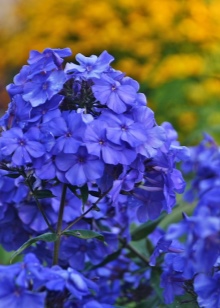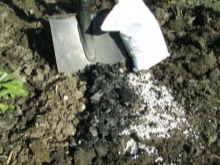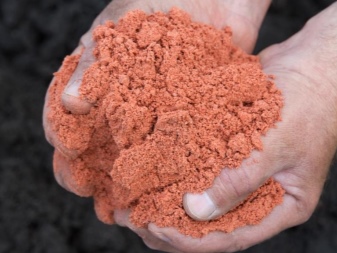Phlox "Blue Paradise": description, planting, care and reproduction

The spectacular appearance of the blooming Blue Paradise phlox is able to make an indelible impression even on the experienced gardener. In the middle of summer, the bush of this amazing perennial is covered with lush caps of fragrant flowers of a lilac-blue hue. At the same time, the original color of flowers is not the only advantage of phlox of this variety. What are their other features? What should be considered when growing?



Description of the variety and its characteristics
"Blue Paradise" is a highly decorative variety of frost-resistant paniculate phlox of Dutch selection. In landscape design, phloxes of this variety are widespread due to their very colorful and unusual flowering. The height of the bushes varies from 0.6 to 1.2 meters. The diameter of the aboveground part can be 0.3-0.6 meters.
Plants are semi-spreading, multi-stemmed, erect bushes. Stems are well branched, strong, dark green. Flowering shoots are strong, elastic, dark purple or purple-burgundy in color. Leaves are dark green, elongated, lanceolate, with a pointed apex.


Plants have a strong, well-developed root system that is shallow in the ground. With the arrival of cold weather, the aerial part of the phlox dies off, and the root system plunges into a state of dormancy. Phloxes of this variety belong to the group of plants with medium early and medium flowering periods. Under favorable conditions, flowering occurs in the second half of summer and continues until autumn. During this period, spherical or conical inflorescences of medium size are formed on the flowering shoots of the plant.
Initially, Blue Paradise phlox buds have a deep dark blue color, which gradually acquires a purple hue. The color of the opened flowers is blue-violet or lilac-purple. The flowers are round, symmetrical, five-petal, reaching 4 or more centimeters in diameter. A notable feature of flower color is its variability during the day. So, with the arrival of twilight, the flowers of phlox of this variety begin to darken, acquiring a deep ink shade.




Phloxes of this variety tend to grow rapidly. With proper care and favorable external conditions, plants actively grow green and root mass, forming beautiful bushes. Another important feature of this variety of phlox is their resistance to fungal diseases. Thus, observations show that these perennials demonstrate high resistance to powdery mildew pathogens.
The variety is frost-resistant, able to withstand winter temperatures down to -30 °. This makes it possible to grow phlox of this variety in regions with cold winters.



Growing features
Like many other varieties of paniculate phlox, Blue Paradise is not considered overly demanding in terms of care and growing conditions. However, in order for these flowering perennials to fully develop and bloom colorfully, they need to ensure:
- the most suitable place on the site;
- timely watering;
- periodic feeding.
Proper preparation of plants for winter requires special attention. It provides for the implementation of a number of simple procedures that must be carried out annually, throughout the life of these unusual phloxes.



Seat selection
For growing phlox varieties "Blue Paradise", well-lit places with a light sparse shade are suitable. It is not recommended to plant them in very shaded corners of the garden and in areas under the scorching sun. Observations show that strong shade and direct sunlight equally negatively affect flowering quality.

Plants will feel most comfortable in an area with well-drained and moderately moist soil. For their cultivation, loose loams with a high humus content are optimal. Experienced flower growers recommend adding a mixture of leaf humus, peat, ash, sand and compost to the soil before planting phlox. Heavy soils should be diluted with sand before planting, and light soils with clay or peat.


When arranging planting pits, it is important to take into account the diameter of the root system of the seedlings. If phlox is planned to be planted in a group, the pits should be placed at a distance of 50-60 centimeters from each other. This arrangement of plants will allow for optimal air circulation around the bushes.
Planting phloxes too close to each other is strongly discouraged, as in the future this can cause a weakening of plant health, massive development of diseases and even death.


Watering
When growing Blue Paradise phloxes, it must be borne in mind that they are a moisture-loving crop. Watering these perennials should be 1 time in 2-3 days (in hot and dry weather, the frequency of watering can be increased). After watering, the soil in the near-trunk circle is mulched, preventing rapid evaporation of moisture.


Top dressing
Gardeners recommend feeding phloxes several times per season. The first feeding is carried out in early spring, when the plants begin to enter the phase of intensive growth. At this stage, complex nitrogen-containing fertilizers are introduced, which contribute to the rapid growth of green mass.
The second time feeding is applied in May-June, when phloxes begin to form buds, preparing for flowering. During this period, they are fed with potassium-phosphorus fertilizers, which activate the budding process and strengthen the root system of plants. The third feeding is carried out in the middle of summer. At this stage, phloxes are fed with potassium-containing fertilizers.
Some gardeners use superphosphate or urea solution as top dressing.



Preparing for winter
When phloxes have completely faded, they are fed with phosphorus-potassium fertilizers and begin to prepare for wintering. Top dressing at this stage is necessary to restore the resources that the plants used up during the budding and flowering period. After feeding, the bushes are cut off, leaving only small hemp 8-10 centimeters high above the ground. Despite the frost resistance of Blue Paradise phlox, it is recommended to cover the surface of the ground around the rest of the bush with humus, and cover the hemp with spruce branches.

Reproduction
Like many other varieties of paniculate phlox, Blue paradise can be propagated by layering, splitting the mother bush or stem cuttings... Florists rarely use the seed method of phlox propagation, since it almost does not guarantee the preservation of varietal traits. It should be noted that in some cases varietal phloxes can spread throughout the site on their own using self-seeding.
Layers
This method is considered one of the most effective and simple. To get a generation of young phlox in this way, it is necessary in the spring to bend several strong lateral stems with buds from the bush, pin them to the ground and dig in. Buried stems should be watered regularly and removed from weeds. After a few weeks, the stems will take root in the ground, and young shoots will begin to form from the buds. By the fall, they will turn into full-fledged plants that can be separated from the bush and planted in a permanent place.

Separation of the mother plant
Gardeners resort to this method of breeding phlox in spring or autumn (at the beginning or at the end of the growing season). For separation, select a healthy, well-developed bush that has reached the age of 5-6 years. The bush is carefully dug out of the ground, being careful not to damage the roots. Then the bush is divided into several parts with hands or with a sharp knife (delenok). The division is carried out in such a way that on each part of the bush there are shoots and a small number of roots.
After the procedure, the delenki are immediately planted in previously prepared places with loose and moist soil. After disembarkation, the delenki are slightly shaded, providing them with protection from direct sunlight and drafts.


Stem cuttings
Experienced growers claim that this method is the most productive and uncomplicated. The most suitable time for this procedure is late May-early June. Cuttings are harvested from green, strong shoots of healthy and mature plants. The shoots are cut in such a way that there are 2-3 knots on each cuttings. The lower leaves are removed from the cuttings, the upper ones are shortened by half.
Then the harvested cuttings are planted in boxes with a loose and well-moistened substrate. As a substrate, ready-made store-bought soils or mixtures are used, consisting of peat, humus, sand, garden soil. The planting of cuttings is carried out according to the scheme of 5x10 centimeters.


Boxes with cuttings are placed in a greenhouse or covered with a spacious transparent container, after which they are shaded. During the entire rooting period, cuttings are watered 2-3 times a day, maintaining high humidity in the greenhouse. In order to prevent decay of the planting material, the greenhouse is regularly ventilated.
Rooting of cuttings usually occurs within 2-4 weeks. A sign of successful rooting is the formation of young tiny shoots in the leaf axils. When the rooted cuttings are completely strong, they are transplanted into spacious containers or on seedling beds for growing. In this case, the landing is carried out according to the scheme of 15x20 centimeters.


Seed propagation
This method is considered laborious and ineffective. Very often, with such a procedure, the varietal characteristics of phlox are lost. This means that a grower propagating Blue Paradise varietal phlox with seeds may not get the expected results. Before sowing, phlox seeds are stratified. To do this, in October-November, they are sown in open ground (before winter) or placed on the lower shelf of the refrigerator, after mixing with sand.
Stratified seeds are germinated at home in March. To do this, they are sown in containers with a moist and loose substrate. It is not necessary to deepen or sprinkle the seeds with earth. After sowing, the container is covered with glass or tightened with foil. Every day, the containers are ventilated to remove condensation, and the crops are sprayed with water from a spray bottle. The first shoots usually appear in 2-4 weeks. When 2 true leaves are formed on the seedlings, a pick is carried out.
Planting mature young plants in open ground is allowed only after the threat of frost has disappeared.


You can take a closer look at the phlox of this variety further.







































































































The comment was sent successfully.